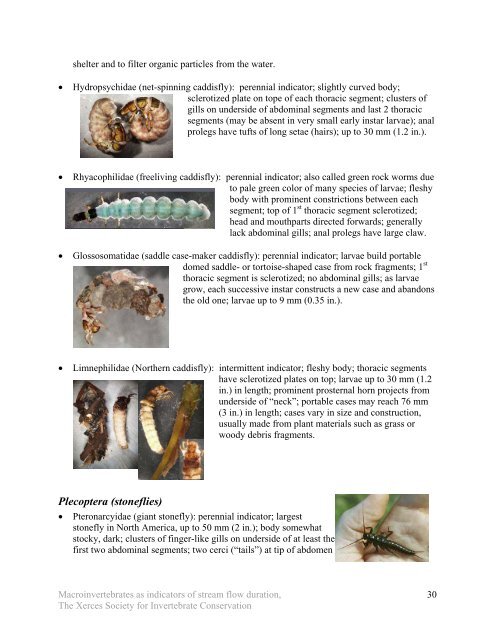Using Aquatic Macroinvertebrates as Indicators of Stream Flow ...
Using Aquatic Macroinvertebrates as Indicators of Stream Flow ...
Using Aquatic Macroinvertebrates as Indicators of Stream Flow ...
Create successful ePaper yourself
Turn your PDF publications into a flip-book with our unique Google optimized e-Paper software.
shelter and to filter organic particles from the water.• Hydropsychidae (net-spinning caddisfly): perennial indicator; slightly curved body;sclerotized plate on tope <strong>of</strong> each thoracic segment; clusters <strong>of</strong>gills on underside <strong>of</strong> abdominal segments and l<strong>as</strong>t 2 thoracicsegments (may be absent in very small early instar larvae); analprolegs have tufts <strong>of</strong> long setae (hairs); up to 30 mm (1.2 in.).• Rhyacophilidae (freeliving caddisfly): perennial indicator; also called green rock worms dueto pale green color <strong>of</strong> many species <strong>of</strong> larvae; fleshybody with prominent constrictions between eachsegment; top <strong>of</strong> 1 st thoracic segment sclerotized;head and mouthparts directed forwards; generallylack abdominal gills; anal prolegs have large claw.• Glossosomatidae (saddle c<strong>as</strong>e-maker caddisfly): perennial indicator; larvae build portabledomed saddle- or tortoise-shaped c<strong>as</strong>e from rock fragments; 1 stthoracic segment is sclerotized; no abdominal gills; <strong>as</strong> larvaegrow, each successive instar constructs a new c<strong>as</strong>e and abandonsthe old one; larvae up to 9 mm (0.35 in.).• Limnephilidae (Northern caddisfly): intermittent indicator; fleshy body; thoracic segmentshave sclerotized plates on top; larvae up to 30 mm (1.2in.) in length; prominent prosternal horn projects fromunderside <strong>of</strong> “neck”; portable c<strong>as</strong>es may reach 76 mm(3 in.) in length; c<strong>as</strong>es vary in size and construction,usually made from plant materials such <strong>as</strong> gr<strong>as</strong>s orwoody debris fragments.Plecoptera (stoneflies)• Pteronarcyidae (giant stonefly): perennial indicator; largeststonefly in North America, up to 50 mm (2 in.); body somewhatstocky, dark; clusters <strong>of</strong> finger-like gills on underside <strong>of</strong> at le<strong>as</strong>t thefirst two abdominal segments; two cerci (“tails”) at tip <strong>of</strong> abdomen<strong>Macroinvertebrates</strong> <strong>as</strong> indicators <strong>of</strong> stream flow duration,The Xerces Society for Invertebrate Conservation30
















